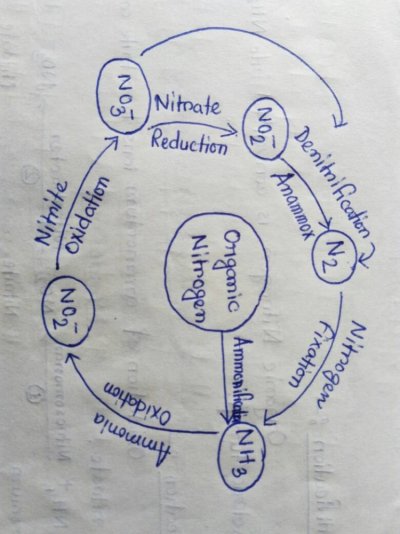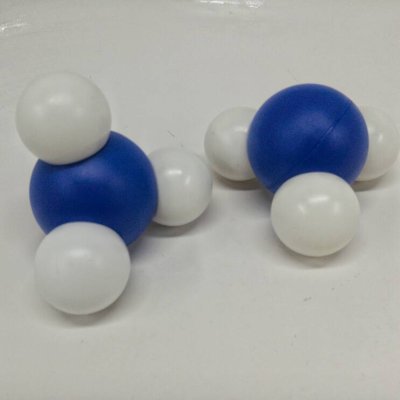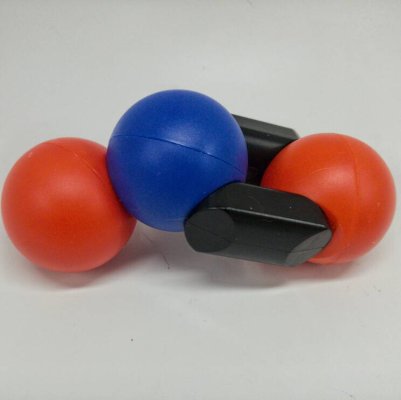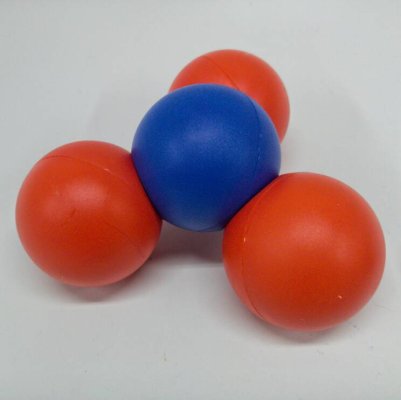You are using an out of date browser. It may not display this or other websites correctly.
You should upgrade or use an alternative browser.
You should upgrade or use an alternative browser.
Nitrogen Cycle Illustrated with Snatoms
- Thread starter nirbhao
- Start date
The friendliest place on the web for anyone with an interest in aquariums or fish keeping!
If you have answers, please help by responding to the unanswered posts.
If you have answers, please help by responding to the unanswered posts.
Hey, that's looking good. What does each colour ball mean?
Can I assume a movie in the works
Can I assume a movie in the works
jarrod0987
Aquarium Advice FINatic
- Joined
- Jul 12, 2005
- Messages
- 512
Hey, that's looking good. What does each colour ball mean?
Can I assume a movie in the works
I suspect blue is Nitrogen, White is Hydrogen, and Red is Oxygen.
nirbhao
Aquarium Advice Addict
Yep. Snatoms uses CPK coloring.
@jarrod0987 recommended that I add the DSB leg of the cycle, and I also want to show each conversion with its byproducts. I don't know about a movie, though!
@jarrod0987 recommended that I add the DSB leg of the cycle, and I also want to show each conversion with its byproducts. I don't know about a movie, though!
Ghillie115
Aquarium Advice Apprentice
Diana Walstads book has a very good and detailed explanation of the nitrogen cycle for freshwater systems
Sent from my SM-G900V using Aquarium Advice mobile app
Sent from my SM-G900V using Aquarium Advice mobile app
Diana Walstads book has a very good and detailed explanation of the nitrogen cycle for freshwater systems
Sent from my SM-G900V using Aquarium Advice mobile app
I must look into getting this book, just to have read it once even.
Ghillie115
Aquarium Advice Apprentice
I must look into getting this book, just to have read it once even.
It's very good. If you like/understand all of the chemical interactions between organic and inorganic compounds and appreciate ecology it's worth it. I'm an environmental engineering major and I found alot of it relating back to my classes and how we identify water quality. It's pretty top notch stuff.
jarrod0987
Aquarium Advice FINatic
- Joined
- Jul 12, 2005
- Messages
- 512
That book changed the way I think about FW systems for ever. It's a lot to take in all at once. I re read it from time to time at least in parts.
Thanks! I'll hunt around for it. Read most from the library now (or looked at the pictures anyways). I think I would be interested in the chemistry side - especially as the chemistry is a little limited in geology (pretty much the rock that got smacked with a hammer last week, will be the same rock this week).
nirbhao
Aquarium Advice Addict
Thank you for sharing!Diana Walstads book has a very good and detailed explanation of the nitrogen cycle for freshwater systems
Sent from my SM-G900V using Aquarium Advice mobile app

Here is the Nitrogen Cycle. Please forgive me for my bad handwriting [emoji37]
Let me describe a little bit more about the cycle.
STEP 1 : AMMONIFICATION
Organic Nitrogens (uneaten Fish food, Fish wastes) are converted into Ammonia by some bacteria within the tank.
STEP 2 : NITRIFICATION
Oxidation of Ammonium ions to Nitrite and then Nitrate.
This is the simplest system found in our aquarium. Now a days some of the latest Aqualogical Institutes are doing their research to make a system that doesn't require to change their water. For doing so, they are trying do the Denitrification as well as Anammox.
In Denitrification, the Nitrate converted to Nitrite, then Nitric Oxide, then Nitrous Oxide and then ultimately to Nitrogen gas that could be escaped from the tank. But the process requires Anaerobic conditions for the growth of the bacteria who are responsible for the whole process. Unfortunately making such Anaerobic conditions within the tank is not possible as well as not desired too.
While on the other hand, in case of Anammox, the Nitrite and Ammonium ions are converted directly into Nitrogen gas without any intermediate steps. But the process requires Anaerobic conditions for the growth of the bacteria who are responsible for the whole process. Unfortunately making such Anaerobic conditions within the tank is not possible as well as not desired too.
jarrod0987
Aquarium Advice FINatic
- Joined
- Jul 12, 2005
- Messages
- 512
I have been working on this too. For years now. I have the denitrification working pretty easy in the tank. FW or SW makes no matter. Maybe Anammox, not sure about how that process works. Unfortunately I have found there are other issues that require we still do WC. Bicarbonate depletion, Metal Accumulation, and Hormone accumulation. 2 of those 3 I solved but the last one...kind of hard. I have a process in mind but it has a big risk factor and so not worth it IMO. I love this post though.
The secret of making anaerobic conditions in the tank is to use the right substrate. The water becomes aerobic very quick when it seeps down into substrate but still plenty aerobic when up in the normal water column. DW talks about that in her book too. I used to do it with soil but I did not like the tannins and it stopped working once the wood (in the soil) broke down all the way. I am trying pumice now. It will not break down. Took a month to get started instead of a day but also does not leach yellow tannins into the water like the wood/soil did. Not sure if it will eventually clog. Working on how fast the rate will be compared to wood/soil. I love watching the little N2 bubbles coming out of my gravel
The secret of making anaerobic conditions in the tank is to use the right substrate. The water becomes aerobic very quick when it seeps down into substrate but still plenty aerobic when up in the normal water column. DW talks about that in her book too. I used to do it with soil but I did not like the tannins and it stopped working once the wood (in the soil) broke down all the way. I am trying pumice now. It will not break down. Took a month to get started instead of a day but also does not leach yellow tannins into the water like the wood/soil did. Not sure if it will eventually clog. Working on how fast the rate will be compared to wood/soil. I love watching the little N2 bubbles coming out of my gravel
Ghillie115
Aquarium Advice Apprentice
I have been working on this too. For years now. I have the denitrification working pretty easy in the tank. FW or SW makes no matter. Maybe Anammox, not sure about how that process works. Unfortunately I have found there are other issues that require we still do WC. Bicarbonate depletion, Metal Accumulation, and Hormone accumulation. 2 of those 3 I solved but the last one...kind of hard. I have a process in mind but it has a big risk factor and so not worth it IMO. I love this post though.
The secret of making anaerobic conditions in the tank is to use the right substrate. The water becomes aerobic very quick when it seeps down into substrate but still plenty aerobic when up in the normal water column. DW talks about that in her book too. I used to do it with soil but I did not like the tannins and it stopped working once the wood (in the soil) broke down all the way. I am trying pumice now. It will not break down. Took a month to get started instead of a day but also does not leach yellow tannins into the water like the wood/soil did. Not sure if it will eventually clog. Working on how fast the rate will be compared to wood/soil. I love watching the little N2 bubbles coming out of my gravel
Pumice? Would you mind sharing a pic of your setup?
Sent from my SM-G900V using Aquarium Advice mobile app
jarrod0987
Aquarium Advice FINatic
- Joined
- Jul 12, 2005
- Messages
- 512
I can do better then that. The crushed pumice (AKA Seachem DeNitrate) is hidden under the gravel. Here is link to the photo bucket with all the pics of the build ;D
I tested Nitrates a hour ago. It has been 2 days since I dosed them up to ~10 ppm.
They are dropping but not nearly as fast as with wood chips. Limited by lack of DOC I expect.
Enjoy ;D
10 Gal Pumice Test Tank Slideshow by jarrod0987 | Photobucket
Slideshow seems all out of order. Sorry about that. To lazy to solve it.
I tested Nitrates a hour ago. It has been 2 days since I dosed them up to ~10 ppm.
They are dropping but not nearly as fast as with wood chips. Limited by lack of DOC I expect.
Enjoy ;D
10 Gal Pumice Test Tank Slideshow by jarrod0987 | Photobucket
Slideshow seems all out of order. Sorry about that. To lazy to solve it.
Ghillie115
Aquarium Advice Apprentice
I see. Interesting. Never heard of that before. Did that turn out to be a planed tank?
Sent from my SM-G900V using Aquarium Advice mobile app
Sent from my SM-G900V using Aquarium Advice mobile app
jarrod0987
Aquarium Advice FINatic
- Joined
- Jul 12, 2005
- Messages
- 512
I see. Interesting. Never heard of that before. Did that turn out to be a planed tank?
Sent from my SM-G900V using Aquarium Advice mobile app
I have done the effect in a planted tank but then had to add nitrates for the plants
This tank has no plants. I feel that we are stealing the thread away from the OP now. Please feel free to PM me any other questions. I am excited to see if @nirbhao makes new models of other related aquarium molecules
Introducing an Anaerobic conditions using the sand substrate is very easy but maintaining it is quite difficult. Because you can't know whether the colonizing bacteria are good for your fishes or not. It has been reported that some of the Anaerobic bacteria are there which are able of making some really bad stuff for your fishes. Like poisonous gases (H2S) or some of the non-toxic but non-desired gases (CO2). So I'll always suggest you to make sure that you are not allowing the growth of any unwanted bacteria in your aquarium. That's why people try to avoid the Anaerobic bacteria as because the system is little bit complex.I have been working on this too. For years now. I have the denitrification working pretty easy in the tank. FW or SW makes no matter. Maybe Anammox, not sure about how that process works. Unfortunately I have found there are other issues that require we still do WC. Bicarbonate depletion, Metal Accumulation, and Hormone accumulation. 2 of those 3 I solved but the last one...kind of hard. I have a process in mind but it has a big risk factor and so not worth it IMO. I love this post though.
The secret of making anaerobic conditions in the tank is to use the right substrate. The water becomes aerobic very quick when it seeps down into substrate but still plenty aerobic when up in the normal water column. DW talks about that in her book too. I used to do it with soil but I did not like the tannins and it stopped working once the wood (in the soil) broke down all the way. I am trying pumice now. It will not break down. Took a month to get started instead of a day but also does not leach yellow tannins into the water like the wood/soil did. Not sure if it will eventually clog. Working on how fast the rate will be compared to wood/soil. I love watching the little N2 bubbles coming out of my gravel
jarrod0987
Aquarium Advice FINatic
- Joined
- Jul 12, 2005
- Messages
- 512
Oops, double posted. Sorry.
jarrod0987
Aquarium Advice FINatic
- Joined
- Jul 12, 2005
- Messages
- 512
Introducing an Anaerobic conditions using the sand substrate is very easy but maintaining it is quite difficult. Because you can't know whether the colonizing bacteria are good for your fishes or not. It has been reported that some of the Anaerobic bacteria are there which are able of making some really bad stuff for your fishes. Like poisonous gases (H2S) or some of the non-toxic but non-desired gases (CO2). So I'll always suggest you to make sure that you are not allowing the growth of any unwanted bacteria in your aquarium. That's why people try to avoid the Anaerobic bacteria as because the system is little bit complex.
I don't agree with much of this. However, I'm working on giving up arguing in fish forums for my new years resolution. Un subing now. This as gone way off topic.
Ghillie115
Aquarium Advice Apprentice
Also, the H2S situation should be of little concern unless you have high concentrations of decomposing organic matter in your tank. Which isn't that common. In nature salt marshes and bogs are places where you get alot of H2S release, which smells of rotten eggs.
Sent from my SM-G900V using Aquarium Advice mobile app
Sent from my SM-G900V using Aquarium Advice mobile app
Similar threads
- Replies
- 29
- Views
- 819
- Replies
- 18
- Views
- 599
- Replies
- 7
- Views
- 582
- Replies
- 8
- Views
- 773



